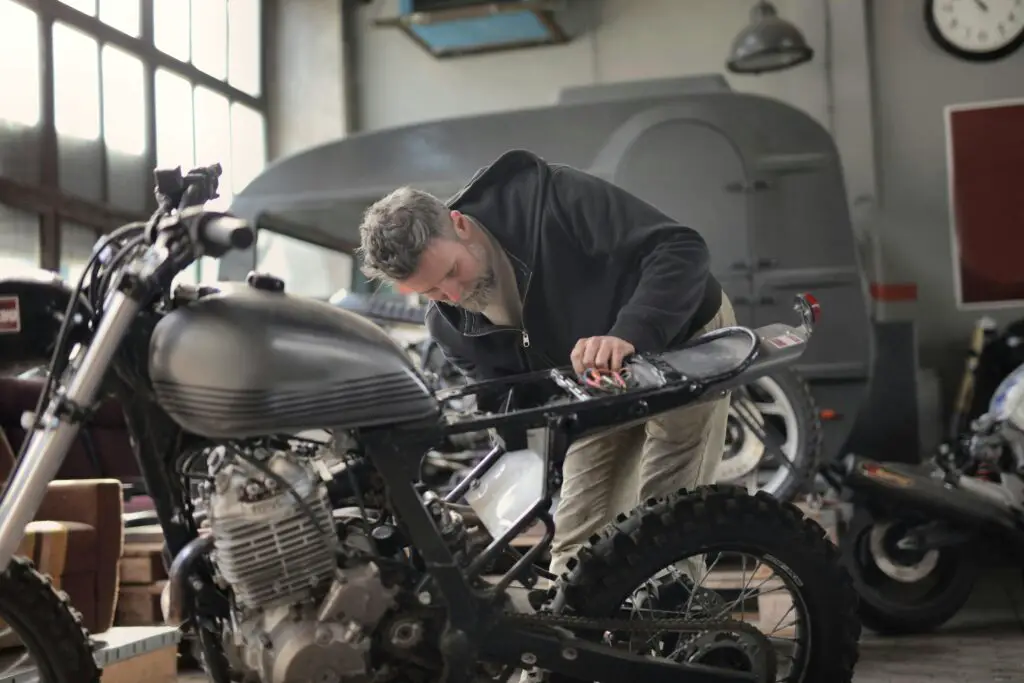How to charge a motorcycle battery without a charger? Motorcycle batteries are essential for starting your bike and powering its electrical systems. However, a dead battery can leave you stranded if you’re not prepared.
While using a dedicated charger is the most effective way to charge a motorcycle battery, there are several alternative methods you can use in a pinch.
In this comprehensive guide, we’ll explore various techniques for charging a motorcycle battery without a charger, ensuring you’re never left stranded on the road.
Understanding Motorcycle Batteries
Before we delve into charging methods, let’s first understand the basics of motorcycle batteries. Most motorcycles use lead-acid batteries, which consist of lead plates submerged in an electrolyte solution. These batteries provide the necessary electrical power to start the engine and run accessories like lights and ignition systems.
Signs of a Dead Motorcycle Battery
Before attempting to charge your motorcycle battery, it’s essential to confirm that it’s the source of your bike’s electrical issues. Common signs of a dead or dying motorcycle battery include:
- Dim headlights or dashboard lights
- Clicking or sluggish starting
- Complete failure to start the engine
If you experience any of these symptoms, your motorcycle battery likely needs to be charged or replaced.
Charging Methods Without a Charger
While using a dedicated battery charger is the most effective way to charge a motorcycle battery, there are several alternative methods you can use when a charger is not available. Here are some techniques you can try:
1. Jump Starting
Jump-starting your motorcycle is a quick and effective way to provide the necessary electrical power to start the engine. To jump-start your motorcycle, you’ll need a set of jumper cables and a vehicle with a charged battery. Follow these steps:
- Position the donor vehicle close to your motorcycle, ensuring that the two batteries are within reach of the jumper cables.
- Connect the positive (+) terminal of the donor vehicle’s battery to the positive terminal of your motorcycle battery.
- Connect the negative (-) terminal of the donor vehicle’s battery to a grounded metal surface on your motorcycle, such as the frame or engine block.
- Start the donor vehicle’s engine and let it run for a few minutes to charge your motorcycle battery.
- Attempt to start your motorcycle. If it starts successfully, disconnect the jumper cables in reverse order.
2. Push Starting
Push starting, also known as bump starting or roll starting, is another method you can use to start your motorcycle with a dead battery. This technique requires some physical effort but can be effective in situations where jump-starting is not an option. Here’s how to push-start your motorcycle:
- Position your motorcycle on a flat surface and ensure it’s in gear.
- Stand beside your motorcycle and hold the handlebars firmly.
- Push your motorcycle forward until you reach a moderate speed (5-10 mph).
- Release the clutch while simultaneously applying the throttle.
- Once the engine starts, release the throttle and clutch, allowing the engine to idle.

3. Charging from a Running Vehicle
In some cases, you can charge your motorcycle battery by running the engine at high RPMs. This method works best with motorcycles equipped with alternators that can generate electricity while the engine is running. Here’s how to charge your motorcycle battery from a running vehicle:
- Connect jumper cables between the running vehicle’s battery and your motorcycle battery, following the same steps as jump starting.
- Start the engine of the running vehicle and let it idle.
- Increase the engine speed to a moderate to high RPM, such as 2000-3000 RPM.
- Allow the engine to run at high RPMs for several minutes to charge your motorcycle battery.
- Once the battery is sufficiently charged, attempt to start your motorcycle.
Precautions and Considerations
While these alternative charging methods can be effective in emergencies, it’s essential to exercise caution and follow safety precautions to avoid injury or damage to your motorcycle:
- Ensure that the donor vehicle’s engine is off when connecting or disconnecting jumper cables to prevent electrical sparks.
- Avoid touching the metal clamps of the jumper cables together, as this can cause a short circuit and damage the electrical systems.
- When push starting, be mindful of your surroundings and ensure that the area is clear of obstacles and hazards.
- If attempting to charge your motorcycle battery from a running vehicle, be aware of the risks of overcharging and damaging the battery or electrical system.
Final Thoughts
While using a dedicated battery charger is the most effective way to charge a motorcycle battery, there are several alternative methods you can use in a pinch. Whether jump starting, push starting, or charging from a running vehicle, these techniques can help you get your motorcycle back on the road when a charger is not available.
However, it’s essential to exercise caution and follow safety precautions to avoid injury or damage to your motorcycle and its electrical systems. By being prepared and knowing how to charge your motorcycle battery without a charger, you can ensure that you’re never left stranded on the road.
Chinedu Chikwem holds a National Diploma in Motor Vehicle Mechatronics from the Institute of Management and Technology (IMT), Enugu, in partnership with Anambra Motor Manufacturing Co. Ltd. Passionate about the automotive industry, he specializes in simplifying complex vehicle concepts and making both traditional and electric vehicle terminology accessible. With a solid foundation in automotive engineering, Chikwem is focused on becoming a leading electric vehicle manufacturer, driving innovation and shaping the future of mobility both across Africa and globally.
Discover more from Chikwem
Subscribe to get the latest posts sent to your email.